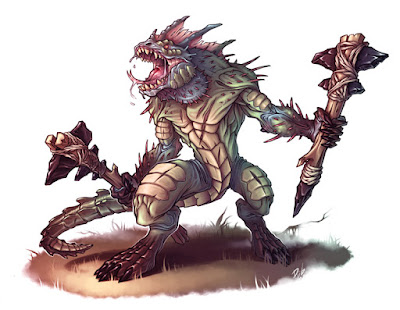I recently stumbled upon Erin Smale's '
Building the Perfect Class' and updated '
Building a More Perfect Class' procedure for building alternative classes for old school or OD&D variants of the game.
Erin did some serious heavy lifting back-calculating experience point/level builds using the original classes/races to develop a matrix for creating or modifying playable races/classes. He broke down HD, saves, equipping, skills, and spell abilities, assigning values to the variables. The outcome is a reasonably balanced approach to class creation, and seems, at face value, to avoid over-powered classes. (He does go on at some length about how the classic magic-user appears to be very hampered by the assigned XP requirements vs his calculated XP, built out via criteria).
So as a thought experiment - I tried a build-out with my
Lizardfolk class that I wrote up a couple years past.
Erin lines out the criteria as such:
1. Hit Dice
2. Class Saving Throw
3. Attack/“to-hit” progression
4. Armor availability or restrictions
5. Weapons availability or restrictions
6. Spell-casting ability
7. Special Abilities: the class’s special abilities, (Erin has an inconsistency in this item - he notes that the abilities are not based on race in his summary, but includes racial abilities in his special abilities list. Since there are no other racial qualifiers elsewhere in the list - I assume this is a typo)
8. Skills: learned skills, not based on race
9. Weapon Mastery: weapon proficiency (from the Rules Cyclopedia, if used, otherwise a generic value)
10. Level Limits - name-level or none?
The individual point options are provided in his document and associated spreadsheet. My lizardfolk-specific notes are summarized below:
1. HD - 400 points (d8 is assigned 300 pts, but I'm adding value for 2HD at 1st level)
2. Saves - 100 points (fighter equivalent)
3. Attack - 500 points ('monster')
4. Armor - 100 points (Restricted to shields)
5. Weapons - 0 points (Racial restriction)
6. Spells - 0 points (this may change, since a 'shaman' class is allowed)
7. Special Abilities - 100 points (Natural armor)
100 (Natural weapons)
100 (Swimming)
100 (Breath-holding)
100 (Infravision)
8. Skills - 0 points
9. Weapon Mastery - 0 points (generic)
10. Level Limit - (-100) points (name level)
Total: 1500 points
Seems realistic - comparable to the cleric class. The target XP is lower than the familiar demi-humans (dwarf, elf, halfling), but this may be representative of the Lizardfolk's perceived primitive or degraded state. Flexing in a cleric-type spell ability option could add 100-400 points to the buy.
The base XP requirement is extrapolated to the appropriate level goals
Therefore - the Lizardfolk-specific class levels line out as:
Lvl XP Required
1
0
2
1,500
3
3,000
4
6,000
5
12,000
6
24,000
7
48,000
8
96,000
9
192,000 (Name-level limit)
Anyway, the BaMPC system appears to be a fairly robust resource for creating player classes for your own world. As always comments or tweaks are welcome.








